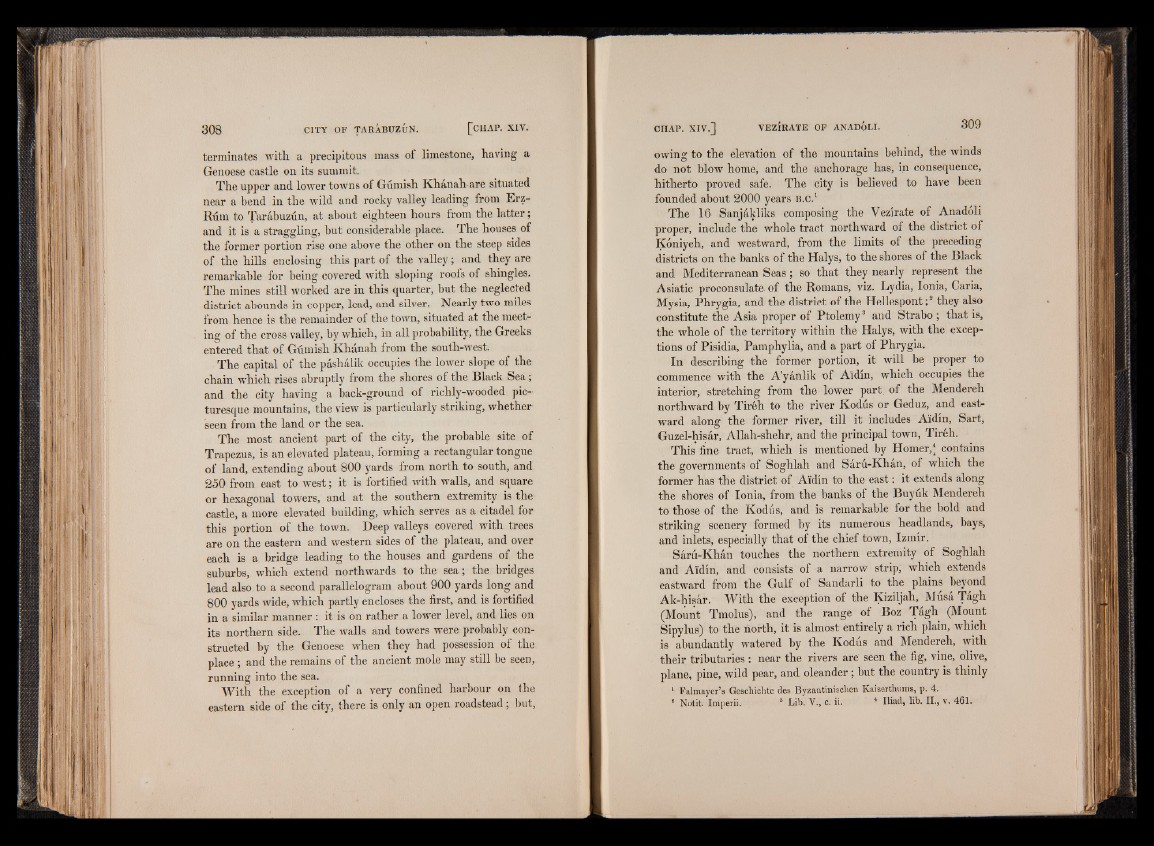
terminates with, a precipitous mass of limestone, having a
Genoese castle on its summit.
The upper and lower towns of Gumish Khanahare situated
near a bend in the wild and rocky valley leading from Erz-
Rum to Tarabuzun, at about eighteen hours from the latter;
and it is a straggling, but considerable place. The houses of
the former portion rise one above the other on the steep sides
of the hills enclosing this part of the valley; and they are
remarkable for being covered with sloping roofs of shingles.
The mines still worked are in this quarter, but the neglected
district abounds in copper, lead, and silver. Nearly two miles
from hence is the remainder of the town, situated at the meeting
of the cross valley, by which, in all probability, the Greeks
entered that of Gumish Khanah from the south-west.
The capital of the pashalik occupies the lower slope of the
chain which rises abruptly from the shores of the Black Sea;
and the city having a back-ground of richly-wooded picturesque
mountains, the view is particularly striking, whether
seen from the land or the sea.
The most ancient part of the city, the probable site of
Trapezus, is an elevated plateau, forming a rectangular tongue
of land, extending about 800 yards from north to south, and
250 from east to west; it is fortified with walls, and square
or hexagonal towers, and at the southern extremity is the
castle, a more elevated building, which serves as a citadel for
this portion of the town. Deep valleys covered with trees
are on the eastern and western sides of the plateau, and over
each is a bridge leading to the houses and gardens of the
suburbs, which extend northwards to the sea; the bridges
lead also to a second parallelogram about 900 yards long and
800 yards wide, which partly encloses the first, and is fortified
in a similar manner : it is on rather a lower level, and lies on
its northern side. The walls and towers were probably constructed
by the Genoese when they had possession of the
place ; and the remains of the ancient mole may still be seen,
running into the sea.
With the exception of a very confined harbour on the
eastern side of the city, there is only an open roadstead; but,
owing to the elevation of the mountains behind, the winds
do not blow home, and the anchorage has, in consequence,
hitherto proved safe. The city is believed to have been
founded about 2000 years b.c.1
The 16 Sanjakliks composing the Yezirate of Anadoli
proper, include the whole tract northward of the district of
Koniyeh, and westward, from the limits of the preceding
districts on the banks of the Halys, to the shores of the Black
and Mediterranean Seas; so that they nearly represent the
Asiatic proconsulate of the Romans, viz. Lydia, Ionia, Caria,
Mysia, Phrygia, and the district of the Hellespont;2 they also
constitute the Asia proper of Ptolemy3 and Strabo ; that is,
the whole of the territory within the Halys, with the exceptions
of Pisidia, Pamphylia, and a part of Phrygia.
In describing the former portion, it will be proper to
commence with the A’yanlik of A'idm, which occupies the
interior, stretching from the lower part, of the Mendereh
northward by Tireh to the river Kodus or Geduz, and eastward
along the former river, till it includes Aidin, Sart,
Guzel-hisar, Allah-shehr, and the principal town, Tireh.
This fine tract, which is mentioned by Homer,4 contains
the governments of Soghlah and Saru-Khan, of which the
former has the district of Aidin to the east: it extends along
the shores of Ionia, from the banks of the Buyuk Mendereh
to those of the Kodus, and is remarkable for the bold and
striking scenery formed by its numerous headlands, bays,
and inlets, especially that of the chief town, Izmir.
Saru-Khan touches the northern extremity of Soghlah
and Aidin, and consists of a narrow strip, which extends
eastward from the Gulf of Sandarli to the plains beyond
Ak-hisar. With the exception of the Kiziljah, Musa Tagh
(Mount Tmolus), and the range of Boz Tagh (Mount
Sipylus) to the north, it is almost entirely a rich plain, which
is abundantly watered by the Kodus and Mendereh, with
their tributaries : near the rivers are seen the fig, vine, olive,
plane, pine, wild pear, and oleander; but the country is thinly
1 Faimayer’s Geschichte des Byzantinisclien Kaiserthums, p. 4.
2 Notit. Imperii. 8 Lib“ V., c. ii. 4 Iliad, lib. II., v. 461.